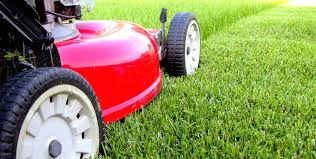A beautiful lawn is the heart of the garden, a playground for the children, for barbecues and to enjoy the sun. There is an estimated 300 million square meters of lawn in the Netherlands! Much of that enormous area is less beautiful than it could be. Yet it is not difficult and not much work to get a (more) beautiful lawn.
Fertilizing, removing weeds, fighting moss and repairing bad patches is best done once winter is over and the grass starts to grow again. This basic maintenance is neither difficult nor time-consuming. With these tips, your lawn will look good all year round.

Weeding
Many weeds in the lawn are beautiful wildflowers that can transform grassland into a beautiful sea of flowers. Think of a beautiful meadow-like lawn with daisies. But weeds can also ruin the even appearance of the otherwise virgin lawn in the garden. In general, very low-growing lawn weeds escape the lawnmower blades. This allows them to spread into a carpet of wide-spreading leaves or a web of long offshoots, which suffocate the grass, create ugly flat spots, and can even carry disease and pests. Remove these weeds now and keep them from returning before the growing season begins. Weed removal is not that much trouble, but if you wait, the weeds have already had a chance to spread and you have extra work.
Chemical control
Chemical weed killers for the lawn have a very specific effect because they have to control the remaining weeds in the lawn without damaging the grass. Most branded formulas contain one or more agents that eliminate broadleaf weeds by affecting the growth-regulating hormones that plants need for healthy development. If you want to control weeds, do this at least a week after mowing, then the weeds will have formed sufficiently large leaves again. After treatment, let the agent work for four days before you start mowing again.
Mow your lawn regularly
One of the easiest ways to keep the lawn weed-free is to mow it regularly.
Use an efficient machine with sharp and clean blades. The wider the mowing range of your machine, the less time it takes to mow. But with wide machines, it is also much more difficult to maneuver on small lawns. A manual mower is sufficient for up to 100 m2 of lawn, above that, a motor mower is more convenient.
Frequent mowing at medium height, twice a week if necessary when the grass is growing hard, is much more effective than mowing irregularly or cutting very short.
If you leave the grass a little longer, the rooting will also be better, which makes the lawn less sensitive to dry weather. It remains beautifully green.
It is best to keep well-fertilized grass about 1 inch (2.5 cm) high to prevent the grass from growing excessively high and consuming unnecessary nutrients. This also stimulates the grass to settle out, creating a dense turf, which reduces the chance of weed growth and the growth of unwanted annual grasses in the lawn.
Raise the lawnmower blades at the beginning and end of the season to make sure you don’t cut the lawn too short. Because outside the growing season, it is better for the lawn to leave the grass a little longer so that it is less vulnerable.
Even in a dry summer, do not mow too short to prevent the grass from drying out.
Read more Autumn, time for a rich harvest

Fertilization and mealtime
Like many other plants, grass needs a balanced ‘meal’ to grow properly and form a beautiful, healthy lawn. Nitrogen is especially important because it ensures strong leaf growth.
Sprinkling lawn fertilizer twice a year provides the lawn with all the nutrients it needs. The need varies depending on the soil type; more is needed on light sandy soil than on clay.
- Check the required quantities carefully.
- Avoid over-liming as this will not benefit finer grasses.
- Some fertilizers are a direct weed killer. With that you kill two birds with one stone. That saves time and money!
- Do not feed in December to January, because the grass does not grow during this period and it is very sensitive to fungal diseases and freezing.
- If you water, do it right! A good splash of water once every fourteen days is better than a little every day. It also takes you much less time.
- Also read: Create your own lawn
Deficiency symptoms
The most obvious symptom of nutrient deficiency is when the grass turns yellow-green all over and grows slowly. The turf can be thin and irregular, giving more chance to weeds and moss. Fertilizing can quickly create a denser mat.
Fertilize more liberally after a wet season once the nutrients have been flushed from the soil. Use less in a dry season, when you’ve watered little or when you’ve left the clippings on the lawn to compost.
Fertilizing tips for the lawn
Choose a windless day to sprinkle fertilizer, when the soil is moist and rain is expected.
Extra nutrients are especially needed when the grass is growing, so wait until April or early May with spring fertilization.
If you have some leftover potting compost or fine compost, you can spread it thinly and rake it in instead of fertilizer.
Do you have an area with wild flowers in the lawn? Then don’t fertilize this. Otherwise, the grass will grow lush, crowding out the flowers.
Moss in the grass
A dense moss carpet is almost always a sign that something is wrong with the lawn. The soil may be poorly draining or too dry or too acidic. There may be too much shade or you maybe mowing the lawn too short. Or a felt layer of grass clippings may have formed. Fortunately, solutions exist for all these problems.
The usual way to deal with moss is to remove the moss with a scarifier rake or, for a larger lawn, with a scarifier. You can also use a leaf rake and use it to rake vigorously through the grass.
Improve the drainage of poorly draining or compacted lawns with a special lawn aerator or by pricking the turf with a spike roller or with a garden fork.
Do you think scarifying is too much work? Then you could also sprinkle the area in question with lawn sand, a mixture of masonry sand, moss control, and lawn fertilizer to encourage the grass to grow. Spread the sand evenly in the recommended amount during a dry period in mid-spring. Do this carefully by hand or with a spreader and wait about a week for the moss control to work. Then grab a leaf rake to rake and remove the burnt moss, sweep small lawn areas with a broom or run a rotary mower over the treated area.
If there is a fat wall of ordinary field rush in the lawn next to moss, this may indicate too high acidity. Check the soil with a pH meter and lime if necessary. Lime improves the soil structure and counteracts acidification of the soil. This makes nutrients more available, allowing the lawn to develop better.
Avoid over-liming as this will not benefit finer grasses. After the moss and felt layer has been removed, it is best to give the lawn a spring fertilizer because this will allow the grass to grow better.
Re-seeding
If the lawn has been scarified or if it has not been fertilized enough, bare spots can occur. Sow these again to prevent moss and weeds from getting the better of them. Loosen the soil, remove weeds, rake it flush with the surrounding lawn and add fine compost if necessary.
Sow the area with suitable grass seed, spreading half of the seed evenly in one direction and the rest in the other. Rake the seeds lightly and protect them from the birds with nets. Or remove the bare piece of grass and replace it with a new sod.

